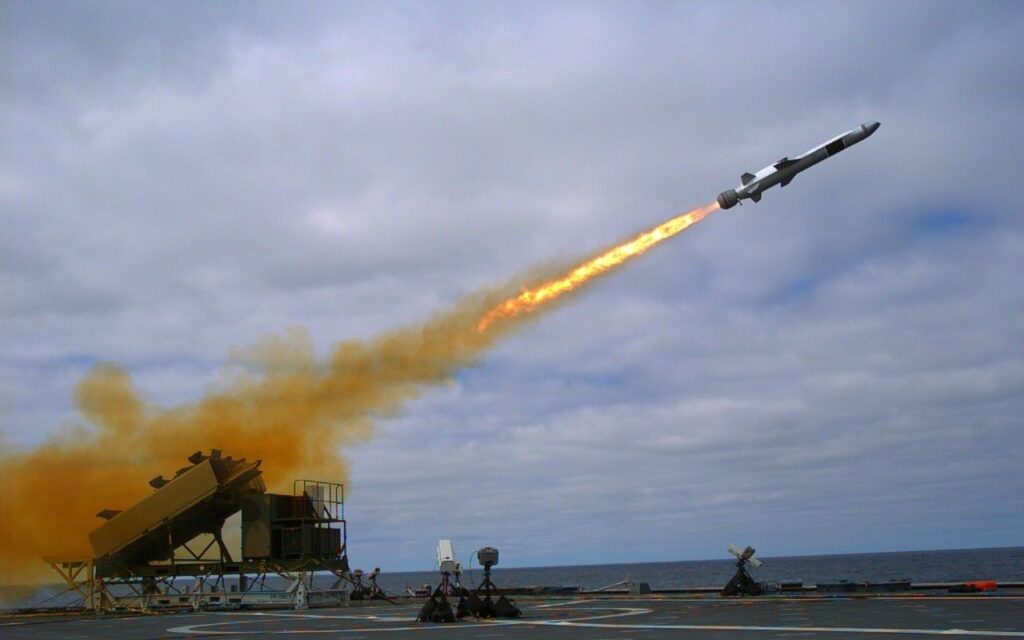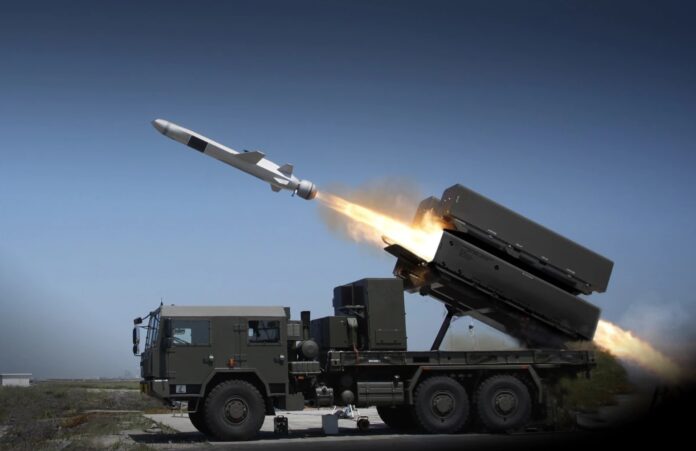The Navy-Marine Expeditionary Ship Interdiction System (NMESIS), a Joint Light Tactical Vehicle armed with Naval Strike Missile, is currently under development for the U.S. Marine Corps. This initiative is part of a larger plan to reconstruct the service. The move also aligns with the U.S Navy’s Distributed Lethality concept to disperse firepower across different platforms. The test was conducted in November 2020, but no pictures were released at that time. Raytheon has released the images on 28th Apr, which is credited to the U.S. Navy. Kim Ernzen, Vice President of Naval Power at Raytheon Missiles and Defense, said in the press release that went along with the new picture of the NMESIS.
NMESIS will enable sea control and denial operations
“Our Naval Strike Missile is a vital weapon for denying enemies the use of key maritime terrain. This test further demonstrates our partnership for advancing the Marine Corps’ modernization priorities of enabling sea control and denial operations.”
The U.S.Marine Corps stated last year that it is not “optimized to meet the demands of the National Defense Strategy.” As a result, the service plans to embark on a 10-year transformation plan that could see many radical changes, including ditching its entire tank force. The program is in line with the view that U.S Marines will have to fight in small groups and distribute any significant conflict in the future.

The service also identifies China as the “pacing threat” to the U.S. and its allies in the coming years. In the event of a conflict between the two countries, the South China Sea will be a major theatre of war. If the dispute escalates to a fight, one of the jobs of the Marine Corps will be to capture the islands in the South China Sea which have been militarized. The islands are relatively small; for example, Fiery Cross Reef is only about 680 acres.
Militarization of island is a significant threat for U.S Navy and Marine
Though China has maintained that it does not intend to pursue militarization, satellite imagery says different. China has excavated deep channels, created and dredged harbors, and constructed communications logistics and intelligence gathering facilities in several islands. In addition, large, hardened airfields and hangers suitable for military operations have been built.
Corps Commandant General David Berger told the House Armed Services Committee in this context, “I think every service chief would love to have a better force. But it would help if you were lethal. It would help if you were mobile. It would be best if you were integrated with the Navy. So, we’re going to reduce the size of the Marine Corps some this year, more next year.”
A complete NMESIS system consists of the unmanned Joint Light Tactical Vehicle (JLTV), also known as the Remotely Operated Ground Unit, Expeditionary-Fires (ROGUE-Fires), and a launcher with two ready-to-fire Naval Strike Missiles (NSM) inside their self-contained launch canisters. The JLTV family has many configurations -Heavy Guns Carrier, Utility, General Purpose, Close Combat Weapons Carrier.
Naval Strike Missile is an upgrade of Penguin Missile
In 2018, the Navy selected the Naval Strike Missile for its over-the-horizon defense of littoral combat ships and future frigates. The USS Gabrielle Giffords (LCS 10) launched NSM in 2019 during Pacific Griffin, a biennial exercise near Guam. In 2019, the U.S. Marine Corps integrated a land-based Naval Strike Missile into its force structure, sharing costs and interoperability with the Navy.
Naval Strike Missile or NSM is the upgrade of Kongsberg’s Penguin short-to-medium range anti-ship guided missile. The missile has a range of 100 miles or 185 km. NSM is a 5th generation missile capable of high subsonic speeds. It has sea skim mode by which it travels very close to the surface and has a stealthy profile, making it hard to detect and intercept. The NSM eludes enemy radar and defense systems by performing evasive maneuvers and flying at sea-skimming altitude. NSM uses an advanced seeker for precise targeting and carries a 500-pound class warhead with a programmable fuze. It is equipped with 276 pounds or 125 kg multi-purpose blast/fragmentation warhead. In addition, NSM features an imaging IR-seeker which is complimented by inertial/GPS navigation.

The missile also has a built-in database of representative ship types to distinguish between intended targets and other objects. Significantly it can be used as an anti-ship missile as well as for taking out land targets.
NSM is also suited for land-attack missions because it can climb and descend with the terrain. It was successfully tested in a land-based mobile launcher configuration in 2018 as part of a multination military exercise. Kongsberg does offer NSM in a ground-launched structure with the missiles being mounted on tactical trucks. However, change is only constant, especially true for modern warfare, which is evolving rapidly.
If implemented, the plan by U.S Marine Corps will see it optimize itself to face the changing dynamics. It is to be noted that unmanned launch vehicles, networked together, could be employed in small groups, bringing lethal fire to a significantly large area.
Conclusion
The operator and the launcher could be deployed in a distributed manner and be much more mobile and flexible. It will mean the rival won’t be able to target them quickly and decisively. The key concept is to rapidly deploy Marines to establish forward bases across a broad area of operations and then rapidly position themselves as per the tactical situation in the battlespace. NMESIS could then be utilized to deter rival’s naval forces from moving into adjacent waters. It will be interesting to see how things pan out in the coming days.
Check out Naval Library App to find out the specifications of Naval Strike Missile.





